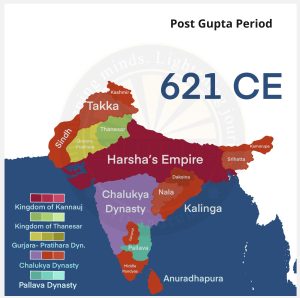Pushyabhuti Dynasty
- Also known as the Vardhana dynasty, they governed areas of northern India.
- Hieun Tsang’s travels account Si-Yu-Ki, Banbhatta’s Harshacharita, and Pulkeshin II’s inscription on Aihole stone.
- The Madhuban and Sonpat inscriptions record chronology. Harshavardhana signed the Banshekhra inscriptions.
- Pushyabhutis were Gupta’s feudatories. They gained independence after the Huna invasion.
- This dynasty’s notable monarchs included Prabhakarvardhana, Adityavardhan, and Harshavardhana.
- He was the son of Prabhakarvardhana.
Harsha
- Following the decline of the Gupta Empire, North India saw political chaos and discord. In the early seventh century C.E., Harshvardhana established a greater dominion in northern India.
- Kannauj was invaded and merged into Thaneswar.
- Harshavardhana battled Shashank of the Gauda Kingdom, establishing dominance over Bengal, Bihar, and Odisha, and befriending Bhashkarvarman of Kamrup (Assam).
- Vallabhi King Dhruvbhata of Gujarat was also vanquished, and peace was reached with him through the marriage of Harsha’s daughter to Dhruvbhata.
- He adopted the titles of Uttarapathanatha or Uttarapathapati (Lord of the North).
- While moving South through the Malwa region, he was defeated by Pulakeshin II in the Battle of Narmada.
- He was profoundly impressed by Hieun Tsang’s charisma and convened a Buddhist assembly in Kannauj under his leadership.
- Hieun Tsang’s book praises Harshvardhan’s righteousness and generosity.

Administration
- Harshavardhana managed his dominion in the same way as Gupta.
- The basic unit of government was a village.
- Offices under the king became hereditary when Harisena, (a ‘maha dandanayaka’ or Chief Judicial Officer), acquired the position from his father.
- One person could hold more than one position, as Harisena also held the offices of ‘Kumaramatya’ and ‘Sangrahvigrahika’.
- Other prominent administrative authorities included the ‘sreshti‘ (chief banker or merchant), the ‘sarthavaha‘ (leader of merchant caravans), the ‘prathamakulika‘ (chief craftsman), and the ‘kayashthas‘ (head of scribes).
- The upkeep of public records is a key aspect of the Harsha government.
Society
- The society was classified into four groups: Brahmin, Kshatriya, Vaishya, and Shudra.
- Brahmins were the most favoured members of society, and monarchs gave them land gifts.
- Women’s status has declined from the liberal era of the past.
- Sati was common, and widow remarriage was restricted in the upper castes.
- Swyamvara (the practice of selecting a husband) had reduced.
- Hiuen Tsang explains three ways to bury the deceased: cremation, river burial, and exposure in the wild.
Religion
- According to inscriptions, the early Pushyabhuti rulers worshipped Surya.
- Rajyavardhana was a Buddhist devotee.
- Harshavardhana appears to have been a Shiva devotee with a keen interest in Buddhism. Nonetheless, he was welcoming of different faiths.
- To disseminate and spread Mahayana Buddhist views, Harsha organised a great meeting in Kanyakubja in 643 CE, presided over by Hiuen Tsang.
- Shramanas, Brahmanas, and sectarian devotees are believed to have been invited to this grand gathering.
- Several subordinate rulers were present, including those from Assam and Valabhi.
- Religious ceremonies were also held every five years in Allahabad, an ancient city. He hosted the Dana ceremony, or gifting ceremony, here for three months.
Art and Culture
- Harshavardhana, a patron of art and literature, supported artists such as Banabhatta, Mayura, and Matanga Divakara.
- Banabhatta penned Harshacharita, Kadambari, and Parvatiparinay.
- Harshavardhana was also a poet who created three Sanskrit plays: Nagananda, Ratnavali, and Priyadarshika.
- He staged five yearly donation (Daan) ceremonies in Prayag, donating generously to the administration, royal household, scholars, and religion.
- The brick temple of Laxamana in Sirpur was built during Harsha’s reign.
Economy
- One-sixth of the produce was taxed and served as the primary source of revenue.
- Other key sources of revenue included port taxes, mine revenues, and vassal tributes.
- Overall, trade and commerce are reported to have declined throughout this period.
